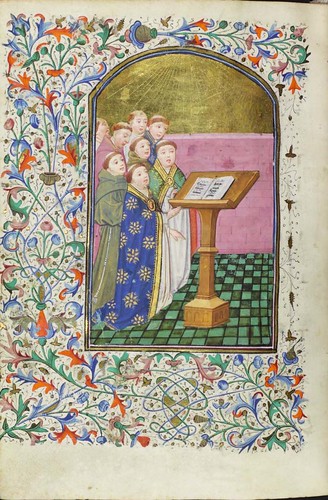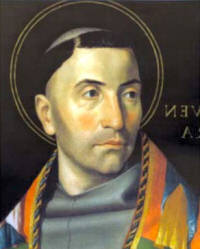The Practice of Lectio Divina - a Source of Joy (1)
 Scripture, part of the foundation of joy (part one, part two tomorrow)
Scripture, part of the foundation of joy (part one, part two tomorrow)
A group of Thomas More College students and myself have just made a trip to the Benedictine community,
St Benedict Abbey, which is at Still River, Massachussetts for a mini-retreat. We arrived for sung Vespers in Latin at 6pm and then left after Compline, which finished about 9.15pm. In between the two Hours, we had dinner with our host, the guestmaster, a talk and period of quiet reflection.
The guestmaster's talk focussed on the contemplation of Scripture, one of the four 'pillars' of the new liturgical movement - Mass, the Liturgy of the Hours, Holy Scripture and Mystagogy (
which I recently wrote about). The form of study of scripture discussed on this occasion was lectio divina. Lectio is required of all monks who follow the Rule of St Benedict, and so I had asked him focus on this aspect to help our students (and me) incorporate it into our daily lives. We were lucky to receive a wonderful, down to earth talk about this form of study of scripture, which gave us some great pointers on how to incorporate it into our own lives.
What was so interesting for me was his description of how the the constant practice of both lectio and participation in the liturgy, Mass and the Liturgy of the Hours, each enriches and deepens participation in the other. So a quotations from the bible in an antiphon at Vespers, for example, might evoke the whole biblical context; and then conversely, how the reading of a phrase in lectio, would evoke the season or feast in the liturgy and place it in the context of our heavenly destiny - the worship of God the Father. Through this dynamic, each reinforces and deepens the experience of the other. As a monk, he told us, he spends more than an hour a day on lectio. As it is unlikely that lay people can regularly devote an hour to this, I asked if it was worth trying to incorporate it for perhaps 10 minutes in a day. Would that still be worthwhile. Oh, yes! I was told. What also struck me was how joyfully and generously it was offered to us. Tomorrow, I post a short summarise what I grasped from his talk and describe how I, and amateur at these things, have tried to put this into practice in my daily routine.
For those who wish to learn more about lectio divina you could always do what we did - go and listen to someone who practices it and will joyfully pass it on to those who ask. Failing that a book that I found very helpful and practical is
"Praying Scripture for a Change" by Dr. Tim Gray.
I recently described,
here, how in my opinion, these the pillars of the new liturgical movement could be a basis of cultural renewal and as such, certainly, are the foundation of the Way of Beauty. But none of this is worth doing unless it is a source of joy, and our visit to the monastery yesterday reinforced the conviction that this is what the Church offers us.
 Here is St Bonaventure (whose picture is shown) from the Office of Readings of Monday Week 5 of the year:
Here is St Bonaventure (whose picture is shown) from the Office of Readings of Monday Week 5 of the year:
'The substance and fruit of holy Scripture is very specific: the fullness of eternal happiness. For this is what Scripture is – its words are words of eternal life, and it is written not just so that we should believe, but specially so that we should possess eternal life in which we may see, and love, and have all our desires fulfilled. When they are fulfilled, then we shall know the superabundant love that comes from knowledge, and so we shall be filled with all the fullness of God. God’s Scripture tries to lead us to this fullness, and to the truth of the preaching of the apostles. It is to this end, with this intention, that we should study holy Scripture, and teach it, and hear it.
If we are to follow the direct path of Scripture and come straight to the final destination, then right from the beginning – when simple faith starts to draw us towards the light of the Father – our hearts should kneel down and ask the Father to give us, through his Son and the Holy Spirit, true knowledge of Jesus and of his love. Once we know him and love him like this, we shall be made firm in faith and deeply rooted in love, and we can know the breadth, length, depth and height of holy Scripture. That news can then lead us to the full knowledge and overwhelming love of the most holy Trinity. The desires of the saints draw them towards the Trinity, in which all that is good and true is and finds its completion.'
Liturgy is the worship of the Father, through the Son, in the Spirit. By worshipping the through and with the Church, which is the mystical body of Christ, we approach the Father. This is what we will do in heaven and we can step supernaturally into this wonderful place and by degrees (not fully before we die) partake of divine nature in this life. Bonaventure is describing this in this little passage above. The liturgy - the Mass
and the Liturgy of the Hours - is how we can do it.
The liturgy is described by Church as the 'source and summit' of human existence. Worship of God the Father in heaven what we are made for, and the liturgy is the source of grace that guides us to it. I cannot imagine anything higher than the prize that contains full and eternal happiness, superabundant love and all our desires fulfilled: and this, according to Bonaventure is precisely what the Church offers us.
For more about Bonaventure, follow link
here.
The painting below is of a monk reading scripture, by Rembrandt.
